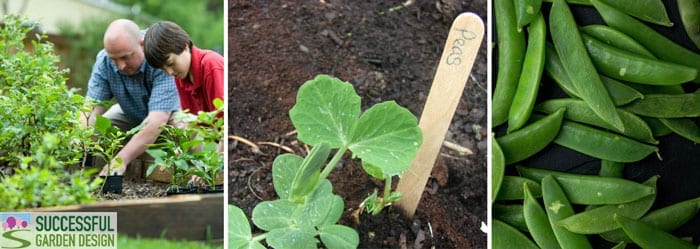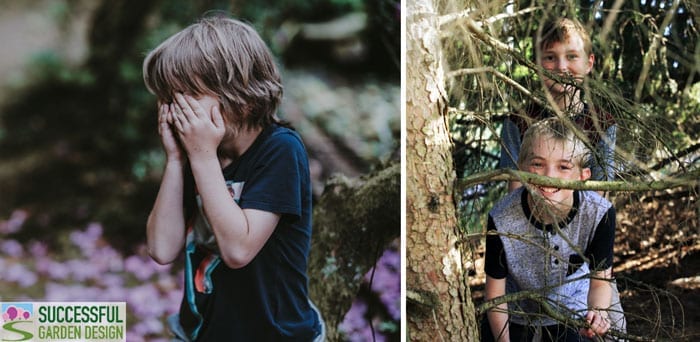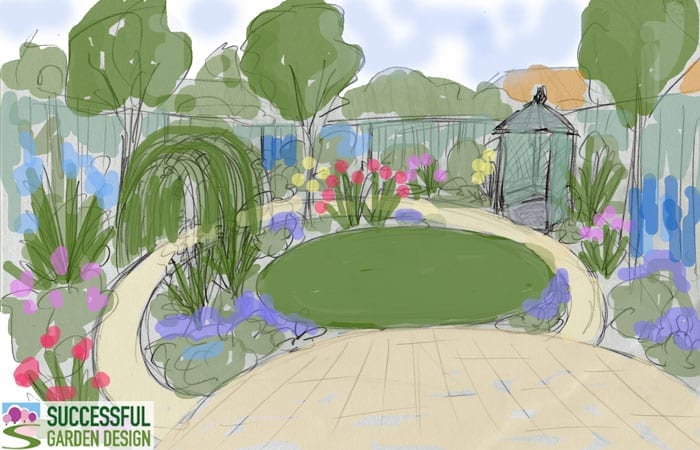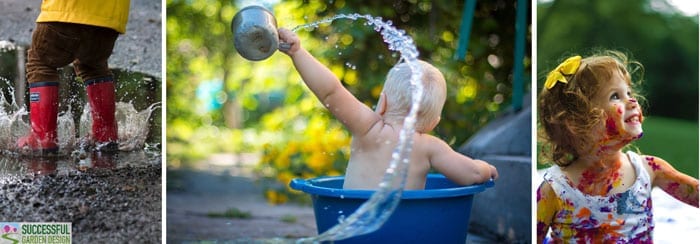SGD reader, Daniela, wrote to me asking for ideas on how to keep children entertained in the garden.
Since I’m no expert on child-rearing, I’ve come up with a few suggestions from my childhood that might help…

Digging for glory, or fun!

Most small children I’ve observed seem to love digging holes and making as much mess as possible, so having a designated ‘dig it up’ section of the garden or a small sandpit enables them to play without wrecking the entire garden.
When children are a bit older you can put all that digging expertise to good use and have them grow things they can eat in the area that was once set aside for digging and playing.
Growing veggies
Start with easy things like peas grown from seed, which are relatively quick to germinate as well as planting tiny strawberry plants from the garden centre.

It’s so valuable for children to be involved with growing – the excitement when something they’ve planted germinates. And then the responsibility to nurture the seedlings and the patience growing them large enough to produce things they can eat.
It’s been so trendy to keep kids well away from anything remotely dirty but experts are now discovering how important it is for us all to come in contact with the soil as it plays an important role in creating and maintaining a healthy immune system.
Garden Adventures
Creating areas in the garden where children can play hide and seek are not only good for them but also an important part of any good garden design.

If you can see the whole garden in one go, it’s a bit like knowing the ending of a book before you read it. What makes a book fun and a garden more interesting is having a few mysteries and bits you can’t quite see at the outset.
There are many ways you can create slightly hidden areas: with trellis, tall planting and even making a willow archway for children to run through and around.
You can order willow sticks for weaving online or use beech hedging plants and train them into an arch as shown in the photo below.

Example fun family garden
In the example garden below, it’s not a particularly large garden but by having the living willow archway with a path circling the lawn, you can’t quite see the whole garden.
Hidden behind the back of the end of the arch is a secret area for children to build dens, dig or do whatever mischief they want (within reason, of course!).

The circular path that wraps around the lawn can be used for cycling around, running, and for the adults, walking around to admire the garden.
A sandpit or blowup plunge pool could be placed on the patio, a swing ball (if those still exist) or mini-trampoline on the lawn and suddenly the nicely designed adult garden is as welcoming for children as it is for adults without it having to look like a children’s playground.
Dens can be made from cardboard boxes joined together, old chairs and tarpaulins and whatever else you’ve got stuffed away unused in the garage!
Make sure you put tough plants around lawn areas which can take having balls and small children land on them. So lavenders with their woody stems will fair much better than soft fleshy plants like hostas and herbaceous peonies.
Make a Mess or Things
Not all play activities in the garden need to be garden specific for children to have fun.
Maybe there’s something really messy like painting or pottery that could keep them occupied outside in a place where you won’t have to worry about what gets spilt. A lawn will soon recover if it ends up multicoloured!

And I’d love making bows and arrows in my ‘Robin Hood phase’ with my most prized possession, a penknife!
Yes, you can tell I grew up in the countryside in an era with little technology and I’m grateful for it.
4 TV stations and only children’s programmes on a Saturday morning allowed me to develop probably my most precious and valued skill… imagination.
An Outside Computer Game
If children are young enough then any garden can be a great adventure playground because of their imagination. But for older ones that love technology more than the outside, then it’s a lot more challenging to keep them entertained.
As wonderful as the virtual worlds are these days the imaginative part has mostly been created by someone else. To encourage children to want outdoor time see if elements of their favourite computer games can be recreated outside and have them use their imagination to create the rest.

Favourite TV characters and role-playing can keep kids occupied for hours – I used to love to pretend I was Zorro! I’d use a cane for a sword and spend hours playing with a plastic pot seeing how long I could keep it airborne with my sword slices!
Cultivating a good imagination is such an important skill. So many things in adult life can be solved with creative problem-solving skills. My entire garden design career has been built around my ability to imagine a different reality and letting my imagination figure out solutions.

Put existing elements to good use
Trees, if they are big enough can be used for swings – as a child, I had one made from a strong branch and a long piece of rope. Simple but effective.
And of course, tree climbing is great fun if that’s still allowed these days!
Logs and a plank of wood can be made into a seesaw.

Water!

What were your favourite garden games as a child?
List them in the comments if I haven’t already covered them here.
Whatever you do in the garden, have fun first and foremost but don’t forget the all-important design principles so that your garden looks goods all year and is more than just a child’s playground. It is possible to have both!
If you’d like to learn more about garden design, then be sure to watch one of my free fast-track garden design classes…


5 replies to "Child’s play in the garden"
Thanks. This is great. My kids are digging a hole in our back garden as we speak. Add some water and hey presto they are entertained for hours! Currently trying to work out how to redesign our shallow wide back garden into somewhere fun for kids but that doesn’t resemble a building site…work in progress.
Hi Alice,
That’s so great to hear! Did you have to hose them down before they were allowed back in the house?! Here’s an article I’ve written that might help you with your shape garden: https://www.successfulgardendesign.com/wide-garden-design-case-study/
Keep us posted with how you get on.
Rachel
Really helpful and interesting
It looks like same flowers positioned in both sides of garden. It’s not possible to accommodate plant sun needs with these big fences. In the original picture those lupins are in massive open space not in a town garden like the diagram shows. So if bluntly follow such a plan it definitely fails.
Hi Liam,
This isn’t a real garden, it’s just a sketch with blobs of colour to give an artist’s impression of planting with no particular plants in mind – it is not a full design plan with specified plants! Although there is an image of lupins above this imaginary garden, they aren’t plants I tend to put in my UK designs because of the pest issues… so yes, it would be a fail if I’d specified lupins in a real garden, but it’s not, just a very quick doodle! ;o)